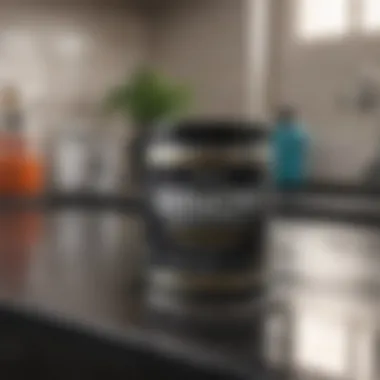Ultimate Guide to Cleaning Kitchen Grease Effectively


Intro
Kitchens are often the heart of the home, serving not just as a place for cooking but also for socializing and family gatherings. However, maintaining a grease-free kitchen can be a challenge. Whether it's from cooking mishaps or just daily use, grease can accumulate on various surfaces, impacting both hygiene and aesthetic appeal. In this guide, we delve into practical methods and natural solutions for cleaning grease from kitchens. The goal is to equip you with knowledge and actionable steps, enabling you to restore order and cleanliness to your kitchen environment.
Understanding the types of grease present in kitchens is essential. Grease can be categorized mainly into animal fats and vegetable oils, both of which require different cleaning approaches. Therefore, recognizing these elements can help you choose the right cleaning methods and products. The significance of regular maintenance cannot be overlooked either; dedicating time to keep surfaces clean not only enhances the overall appearance but also helps prevent future buildup.
This article will cover effective techniques, natural solutions, and maintenance tips specifically designed for various kitchen surfaces, such as countertops, stoves, and cabinets. We will also provide insights into the importance of cleaning frequency and organization in your kitchen tasks. By the end, you will have a comprehensive understanding of how to tackle kitchen grease effectively.
Prolusion to Kitchen Grease
Understanding the concept of kitchen grease is essential in maintaining a clean and safe culinary space. Grease buildup can have multiple adverse effects, ranging from health hazards to compromising the aesthetic integrity of the kitchen. This section will explore what kitchen grease is, its various sources, and the implications of neglecting its presence.
Understanding Kitchen Grease
Kitchen grease is a byproduct created during cooking when fats and oils are heated. As temperatures rise, these substances can splatter and settle on surfaces. This residue not only makes surfaces look unsightly but also poses significant hygiene issues. Grease can harbor bacteria, which increases the risk of foodborne illnesses. Therefore, having a proper understanding of grease and its properties is fundamental for anyone who spends time in the kitchen. Identifying these risks emphasizes the importance of regular cleaning, ultimately leading to a healthier environment.
Sources of Kitchen Grease
Various sources contribute to the accumulation of kitchen grease, making it pertinent for homeowners to recognize these factors to better manage and reduce buildup.
Cooking Methods
Different cooking methods play a significant role in how much grease is generated. Frying, for example, is highly impactful as it involves cooking food in hot oil. This method creates a high volume of grease that often escapes onto surfaces, particularly surrounding stove areas. Another common method is grilling, which can also produce splatter, albeit less than deep frying. Each technique has its own characteristics: while frying is quick and flavorful, it demands extensive cleanup due to excess grease.
Food Types
Not all foods create the same level of grease. For instance, fatty cuts of meat generate more oil during cooking compared to leaner alternatives like chicken breast or fish. Cooking methods involving butter or oil-based sauces further increase grease production. The choice of food significantly impacts the kitchen's cleanliness, as greasy foods require more diligent cleaning efforts to prevent buildup. Awareness of food choices contributes to effective management strategies for kitchen hygiene.
Environmental Factors
Environmental elements such as humidity and ventilation also influence grease accumulation. In poorly ventilated spaces, smoke and vapors linger longer, leading to grease settling on surfaces. High humidity can exacerbate the issue by promoting moisture retention, allowing grease to cling to kitchen surfaces. Conversely, good ventilation can mitigate some of these effects, promoting dispersion of steam and grease particles. Understanding these environmental aspects is crucial for implementing successful strategies that enhance kitchen cleanliness.
Regularly identifying and addressing sources of grease helps keep the kitchen sanitized and inviting, fostering a more enjoyable cooking experience.
The Importance of Regular Cleaning
Keeping a kitchen clean is not merely about aesthetics; it speaks volume about health and functionality. Regular cleaning, especially of greasy surfaces, plays a crucial role in maintaining a safe environment. Grease buildup poses numerous challenges that go beyond an unappealing appearance. Failing to address grease residue can cultivate germs, attract pests, and even pose fire hazards. Thus, making the decision to engage in regular cleaning prevents various potential risks and assures a well-functioning kitchen.
Health Risks Associated with Grease Buildup
Grease accumulation can create a breeding ground for bacteria and other microorganisms. This is particularly concerning around food preparation areas. Contaminated surfaces may lead to foodborne illnesses, which can severely affect your health. In addition, inhaling smoke and fumes generated by cooking can irritate respiratory conditions, particularly in households where individuals suffer from allergies or asthma. Regular cleaning mitigates these health risks, ensuring a safer cooking and dining experience.
Aesthetic and Functional Benefits
A clean kitchen contributes significantly to the overall ambiance of a home. A shiny countertop, gleaming stovetop, and spotless hood not only look inviting but also enhance the functionality of kitchen spaces. When surfaces remain uncluttered and clean, food preparation becomes a stress-free activity. Moreover, having a tidy kitchen encourages better organizational habits and may even foster healthier eating practices. It is essential to keep in mind that cleanliness reflects personal values and can impress guests. Thus, maintaining a regular cleaning schedule is beneficial on all fronts.
Essential Cleaning Supplies
Cleaning grease from the kitchen requires careful preparation. Essential cleaning supplies play a crucial role here. Having the right tools and substances makes the process more effective and less time-consuming. Both commercial and natural cleaning solutions are available. By understanding these options, homeowners can select what works best for their needs.
Commercial Cleaners
Types of Cleaners
Commercial cleaners are widely used in kitchens for their efficiency. They come in various formulations designed specifically for grease removal. Some common types include degreasers, multi-surface cleaners, and solvents.


- Degreasers: These are potent solutions that break down grease effectively.
- Multi-Surface Cleaners: These are versatile and can clean various surfaces, not just grease.
- Solvent-based Cleaners: These can dissolve tough grease but may need careful handling due to strong chemicals.
A distinct feature of commercial cleaners is their quick action. They target grease stains directly, cutting through buildup. However, there can also be disadvantages. Some cleaners may contain harsh chemicals that can be harmful. Careful choice is necessary to avoid adverse effects on both health and surfaces.
Choosing the Right Product
Choosing the right product is essential for effective cleaning. Factors to consider include the type of grease, surface material, and potential health impacts. A specific feature of good cleaning products is the labeling, which often indicates the surfaces and types of stains they can handle effectively.
- Compatibility: Ensure that the product matches the surface material to avoid damage.
- Safety: Check for eco-friendly options or products with fewer harsh chemicals.
Understanding the unique features of products helps in selecting the best option. Some may work well but can leave residues or strong odors, which might not be desirable in a kitchen.
Natural Cleaning Solutions
Natural cleaning solutions are popular for their environmental benefits and safety. These methods are effective and less toxic compared to commercial options. Three powerful natural cleaners are baking soda, vinegar, and lemon juice.
Baking Soda
Baking soda is a well-known kitchen staple that serves as an effective cleaning agent. Its key characteristic is its mild abrasiveness, which helps scrub away grease without scratching surfaces. Another unique feature of baking soda is its deodorizing ability. It absorbs odors, making it a versatile cleaner.
- Advantages: Cheap, safe for food surfaces, non-toxic.
- Disadvantages: Might require more effort for heavy stains.
Vinegar
Vinegar is another fantastic natural cleaner. It is acidic, which enables it to break down grease and grime effectively. A significant advantage of vinegar is its ability to cut through odors as well. It can be used on many surfaces, though caution is needed on natural stone.
- Advantages: Inexpensive, versatile, safe for the environment.
- Disadvantages: The strong smell can be off-putting for some users.
Lemon Juice
Lemon juice is appreciated for its refreshing scent and natural acidity. This acidity makes it effective at breaking down grease stains. Moreover, the added bonus is that lemon acts as a natural antibacterial agent, which is useful in kitchens.
- Advantages: Pleasant scent, natural antibacterial properties.
- Disadvantages: Can be less effective against very tough stains compared to commercial cleaners.
Using natural solutions can decrease dependence on harsh chemicals, promoting a healthier environment.
Step-by-Step Cleaning Process
The process of cleaning grease in the kitchen is systematic and crucial for maintaining a safe and hygienic environment. It involves various steps that ensure thorough cleaning and prevention of future buildup. Each step not only contributes to the cleanliness of surfaces but also minimizes health risks and prolongs the life of kitchen appliances. A well-organized approach helps streamline the cleaning task, making it manageable and effective.
Preparing the Area
Gathering Supplies
Gathering supplies is the first vital step in the cleaning process. This involves collecting all necessary cleaning products and tools before starting. By having everything at hand, you can avoid interruptions and complete the task efficiently. Common supplies include degreasers, sponges, scrub brushes, microfiber cloths, and protective gloves. Each item plays a specific role in dissolving grease and preventing scratches on surfaces.
A key characteristic of gathering supplies is the ability to customize your cleaning kit based on your specific kitchen needs. This can lead to choosing the right cleaners that break down grease effectively, without causing harm to your surfaces.
A disadvantage may arise if you overlook specific products; certain surfaces require specific cleaners. For instance, using an abrasive scrubber on a delicate surface may cause irreversible damage. Thus, being prepared with appropriate materials is beneficial for effective cleaning.
Protecting Surrounding Surfaces
Protecting surrounding surfaces is equally important. This step involves covering areas that are not the focus of cleaning, such as countertops adjacent to greasy spots, cabinets, and floors. Using coverings like plastic sheets or old towels minimizes the risk of contamination or damage during the cleaning process.
The key characteristic of protecting surfaces is to ensure that grease splatter during cleaning does not create additional mess. It can also help in maintaining a safer working environment, as slippery spots may result in accidents.
One unique aspect of this practice is the emotional relief it offers; knowing that other parts of the kitchen are shielded reduces stress during rigorous scrubbing sessions. However, it can be viewed as a disadvantage in terms of time commitment, as this step may add a few extra minutes before actual cleaning begins.


Cleaning Kitchen Surfaces
Countertops
Cleaning countertops is essential as they are one of the most used surfaces in the kitchen. Countertops gather crumbs and grease during meal preparations, leading to potential growth of bacteria if left unattended.
A beneficial characteristic of countertop cleaning is that it can be done with various cleaners. For instance, a mixture of baking soda and water is effective and safe for most materials.
However, certain countertop materials, like granite or marble, require specific cleaners that won’t harm their surfaces. Using the wrong product can result in dull or damaged finishes.
Stovetops
Stovetops are another critical area that demands attention. Grease can accumulate around burners and knobs, which may lead to smoke or even fire hazards if left uncleaned.
The unique feature of stovetop cleaning is that it often requires different techniques, depending on whether it is a gas or electric stove. For example, gas burners may need disassembling to clean thoroughly while electric models usually require just a good wipe-down.
An advantage is that many stovetop cleaners dissolve grease quickly, allowing for a quicker clean-up without much scrubbing. However, using wrong products might affect the finish of the stovetop, so selecting a suitable cleaner is vital.
Ovens
Ovens represent one of the most challenging areas for cleaning due to their persistent grease buildup from spilled food. It is essential to clean interiors periodically to maintain cleanliness and functionality.
One key aspect of oven cleaning is that modern ovens often come with self-cleaning features, allowing for easier maintenance. Running the self-cleaning cycle is usually effective for eliminating complex grease.
An advantage of this is the time it saves; however, this feature may heat the oven to very high temperatures, which may not be suitable for all users. It is crucial to consider your oven's manual to avoid misuse.
Hoods and Vents
Cleaning hoods and vents is crucial due to their role in absorbing grease-laden fumes from cooking. Over time, these components can become heavily soiled, compromising air quality in the kitchen.
A notable characteristic of cleaning hoods and vents is that many of them have removable filters, which can usually be washed separately. This adds an element of ease to the cleaning process.
However, neglecting these areas can lead to reduced efficiency of hoods and unwanted odors. Thus, regular cleaning not only improves air quality but also prolongs the effectiveness of ventilation systems.
Dealing with Stubborn Grease Stains
Applying Heat
When facing stubborn grease stains, applying heat can be an effective strategy. Heat loosens grime, making it easier to scrub away. This is particularly useful for materials that tolerate higher temperatures.
A key feature of applying heat is that it accelerates the cleaning process tremendously. A simple hot cloth or steam can work wonders on tough stains.
However, caution is essential, as not all surfaces can withstand high temperatures. Damage can occur if the heat is too intense, making it a tactic to use selectively and thoughtfully.
Scrubbing Techniques
Scrubbing is often necessary to remove tough grease stains. Various techniques can be employed, including circular motions or back-and-forth scrubbing, depending on the surface being cleaned.
A key characteristic of effective scrubbing is using the appropriate tool. For example, a soft sponge works well on delicate surfaces, whereas a scrub brush may be necessary for heavily soiled areas.
An advantage of using the right scrubbing technique is that it maximizes efficiency and reduces effort in cleaning. However, using excessive force can cause scratches or damage, underscoring the need to balance pressure with technique.
In summary, the step-by-step cleaning process which includes preparing the area, cleaning surfaces, and addressing stubborn stains is essential for maintaining a grease-free kitchen, ensuring both safety and cleanliness in your cooking space.
Maintenance Tips to Prevent Grease Accumulation


Grease accumulation in the kitchen can lead to unsightly stains, unpleasant odors, and potential fire hazards, making it crucial for homeowners to put in place effective maintenance practices. Preventing grease buildup not only saves time and effort in cleaning but also ensures a healthier cooking environment. By committing to regular maintenance habits, the effort required for deep cleaning can be significantly reduced. This section will discuss practical strategies for maintaining a grease-free kitchen.
Daily Cleaning Habits
Incorporating simple daily cleaning habits can significantly reduce grease accumulation. Here are effective practices:
- Wipe Down Surfaces: After each cooking session, take a few moments to wipe down your countertops, stovetops, and other surfaces. Use a damp cloth and a mild cleaner to remove any splatters or spills immediately.
- Use a Splatter Guard: When frying or cooking high-fat foods, use a splatter guard over pans. This can minimize grease from escaping into the air and settling on surfaces.
- Stay Organized: Designate a space for oils and greasy substances. Minimizing their exposure outside of use can help keep your kitchen tidy.
- Ventilation: Turn on your kitchen exhaust fan while cooking. This will help to circulate air and remove greasy vapors, which often contribute to buildup on surfaces.
- Regularly Empty Trash Bins: Keep food residues in check by emptying your trash bins daily, especially if they contain items that may attract pests or emit unpleasant odors.
By practicing these daily habits, you transform your kitchen into a more manageable space, reducing the likelihood of having to perform extensive cleanings later.
Weekly and Monthly Maintenance
In addition to daily cleaning, a structured weekly and monthly maintenance plan can help you stay ahead in the battle against grease accumulation. Consider the following strategies:
- Deep Clean Cooking Appliances: Once a week, take time to clean your major cooking appliances. This includes scrubbing the stovetop, inside the oven, and wiping down the microwave. Clear out any food debris to prevent unwanted odors.
- Wash Vent Filters: If your kitchen has a range hood with filters, wash these filters at least once a month, or more often if you cook frequently. Grease can clog filters, diminishing their effectiveness and becoming a fire risk.
- Inspect and Clean Cabinetry: Check the front and tops of your kitchen cabinets weekly for collecting dust and grease, especially near cooking areas. Use a suitable cleaner to maintain their appearance.
- Clean the Refrigerator Interior: Monthly, check the interior of your refrigerator for spills or expired items. Cleaning these can greatly reduce any lingering odors and potential grease buildup.
- Create a Cleaning Schedule: Regularly updating your cleaning schedule helps ensure that no task goes overlooked. This management strategy can prevent grease from becoming entrenched in various surfaces in the kitchen.
By establishing these cleaning schedules, you not only preserve the aesthetic of your kitchen but also contribute toward a more functionally safe cooking environment.
Regular maintenance is vital. Simple daily habits, combined with focused weekly and monthly cleaning, can keep grease accumulation to a minimum.
Implementing these maintenance tips will ensure that your kitchen remains both clean and functional, setting a strong foundation for a pleasant cooking experience.
Special Considerations for Different Kitchen Styles
Understanding how to clean grease effectively varies greatly depending on the kitchen style. Professional kitchens and home kitchens have unique requirements, each influencing the best practices for maintaining cleanliness. The specific elements of these environments dictate the cleaning methods, the frequency of cleaning, and the types of supplies used. This section explores how to approach grease cleaning in each kitchen setting, ensuring optimal health and functionality.
Professional Kitchens
In professional kitchens, the stakes are higher. Chefs work long hours, preparing large quantities of food, often resulting in significant grease buildup. It's not just about aesthetics; a clean kitchen is crucial for food safety and hygiene. The cleaning process must be systematic and thorough.
- Use of Industrial Cleaners: Many professional kitchens rely on industrial strength cleaners designed for heavy-duty grease removal. Products like Easy-Off and Zep are preferred for their efficiency.
- Daily Deep Cleaning: Unlike home kitchens, every inch of a professional kitchen requires daily attention. This means regular cleaning of surfaces, walls, and equipment to prevent grease accumulation.
- Specialized Equipment: Equipment such as fryers and grills often require specific cleaning tools, like scrapers and degreasers. Knowing how to use these tools properly is essential.
- Employee Training: Staff should be trained not just in cooking but also in maintaining cleanliness. Daily routines should include wiping surfaces after each use.
This meticulous approach minimizes the risk of fire hazards and ensures compliance with health regulations. A professional kitchen's cleaning habits reflect its operational standards, making it crucial for success.
Home Kitchens
Home kitchens, while less intensive in terms of grease production, still present challenges. The cleaning methods can differ vastly from those in commercial settings. Homeowners need practical solutions that fit their lifestyle and cooking habits.
- Routine Maintenance: Unlike the professional setting, home kitchens can benefit from a mix of daily light cleaning and deeper weekly or monthly scrub sessions. This helps to prevent grease from becoming entrenched.
- Natural Cleaning Solutions: Many homeowners prefer natural solutions using items like vinegar, baking soda, and lemon juice. These products effectively cut grease without harsh chemicals, making them safer for family use.
- Focus on Key Areas: Home kitchens usually accumulate the most grease around stovetops, backsplashes, and hood vents. Targeting these areas with focused cleaning efforts can yield significant results.
- Flexibility in Cleaning: Homeowners can afford a more flexible schedule for cleaning. It’s advisable to clean immediately after meal prep and to address any spills or splatters right away.
Overall, effective grease removal in a home kitchen is about creating a habit of cleanliness that suits the cooking frequency and types of meals prepared.
"Regular, structured cleaning can transform a messy kitchen into a welcoming space for cooking and gatherings."
By recognizing the specific considerations for different kitchen styles, efficiency in grease cleaning can be enhanced. The methods vary, but the end goal remains the same: a clean and safe cooking environment.
Finale
Summarizing Effective Grease Cleaning Practices
Effective cleaning practices hinge on understanding the types of grease and their sources. Homeowners should utilize suitable cleaning supplies, whether commercial or natural. The step-by-step methods laid out throughout the article, pinpointing the cleaning requirements for diverse kitchen surfaces, provide a strong framework for tackling grease issues. Here are several key strategies to remember:
- Use Appropriate Cleaners: Choose the right products based on the surface type. For example, vinegar works well on stainless steel but less effectively on plastic.
- Tackle Stubborn Stains: For difficult grease marks, employing heat or specialized scrubbing techniques can yield better results.
- Routine Cleaning: Establishing a cleaning schedule can drastically reduce the volume of accumulated grease over time.
These summarized practices not only facilitate the cleaning process but also contribute to a long-term maintenance strategy for the kitchen.
Encouragement to Maintain a Clean Kitchen
Taking steps to maintain a clean kitchen is a continual effort, but the payoffs are considerable. A tidy kitchen is more inviting and enhances the overall cooking experience. Beyond hygiene, it fosters a sense of pride in one’s home. Here are aspects to consider:
- Implement Daily Habits: Simple actions, like wiping surfaces after use, can inhibit grease from solidifying.
- Regular Inspections: Periodically check kitchen areas for grease buildup, especially near cooking appliances, to catch problems early.
- Involve the Family: Encourage everyone in the household to participate in maintaining cleanliness. Distributing tasks makes it easier and more manageable.
Keeping a clean kitchen is not just about appearance; it plays a critical role in health and well-being. By adhering to the techniques and insights outlined in this guide, owners can cultivate a kitchen environment that is clean, safe, and conducive for cooking and gathering.







